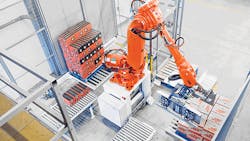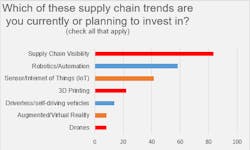Supply Chain Investing in Technology for Current Gain, Not Future Use
While technologies such as drones, virtual reality and autonomous vehicles are getting a lot of attention, supply chain executives are more focused on the new technologies and solutions that can have incremental but impactful changes today in their supply chains and bottom line, according to a new survey.
The State of the 3PL Innovation Survey, conducted by Kenco, recently asked supply chain leaders from a range of industries to get a deeper understanding of how they define innovation, which technologies will have the greatest impact, and plans for the future of innovation.
When asked which areas leaders are planning to invest in, the top three areas of interest are:
- Supply chain visibility (83%)
- Robotics and Automation (58%)
- Sensors/IoT (42%)
However, many of the headline-making innovations – like drones (8%), augmented reality (8%) and driverless vehicles (14%) – ranked lowest on the list.
These responses mirror the maturity of each technology: this graph could just as accurately be labeled “The length of time each of these innovations has been in the market,” said Kenco. It indicates that while supply chain executives have their eyes on the newest emerging innovations, there is clearly a more measured approach to adoption.
This is also evident when leaders were asked about how important each of these technologies is for their business: 64% deemed supply chain visibility as a high priority, while drones (42%) and driverless vehicles (40%) were equally indicated as not a priority (at least, for now).
Despite the promise that the future holds and their interest in progress with emerging technologies, supply chain leaders are most interested in adopting innovation for today, which includes some proven technology and the emerging solutions that are easier to prove such as IoT.
“Working with such a finely tuned supply chain – and with so much on the line – they can’t afford to take a gamble on a new technology that might slow down their processes – or fail entirely,” the report says.
However, adjacent and transformational innovations – technologies that have the potential to transform or completely upend an industry, like robotics or driverless cars – hold a different kind of weight: one of much promise, but a slower approach to adoption. While transformational innovations are lower on the business priority list currently, it’s important for them to be on the radar of supply chain leaders.

